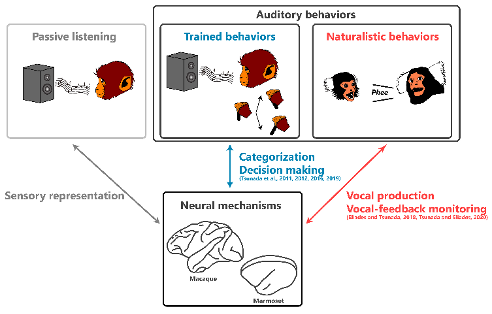We have been tackling a challenge in auditory neuroscience: bridging a gap between our understanding of primate auditory behaviors and their neural mechanisms.。Previous work focused on neural mechanisms of task-trained auditory behaviors, auditory categorization and perceptual decision-making (Tsunada et al., 2011, 2012, 2016, 2019). We recently started studying naturalistic auditory behavior, vocal communication (Eliades and Tsunada, 2018; Tsunada and Eliades, 2020).

In the Tsunada Laboratory, we aim to reveal the behavioral and neural mechanisms of vocal communication and its disorders. Vocal communication plays an important role in maintaining group cohesion and social bonds of both humans and many animal species. A key feature of human conversational communication, however, is our ability to flexibly modify and control our speech depending upon the communicative context, taking into account recent history, conversational contents, as well as the specific speakers and listeners involved. Despite a long history of behavioral and neural studies on vocal communication, it remains poorly understood what behavioral and neural mechanisms enable us to control vocal interactions according to the communicative context.
We aim to demonstrate the underlying behavioral and neural mechanisms of normal social vocal communication using a highly vocal primate species, marmoset monkey. A better understanding of the mechanisms of normal vocal communication will inform our understanding of how and why patients with mental (e.g., schizophrenia) or developmental (e.g., autism spectrum disorder) disorders have problems in vocal communication, thereby contributing to develop new therapeutic approaches to improve their communication.
我们希望找到语言交流及其障碍的行为和神经机制。语言交流在人类和许多其他动物中具有重要的意义,如维持团队联系和社会纽带。人类语言对话的一个重要特点是我们能根据交流语境,如谈话历史、谈话内容、以及发言者和听众,灵活地改变和控制我们的发言。虽然研究语言的行为和神经基础有很长的历史了,我们对根据交流语境控制发声这一能力的行为和神经基础依旧知之甚少。
我们希望使用具有丰富发声行为的狨猴去揭示正常社会声音交流的行为和神经基础。更好的了解正常声音交流的机制可以帮助我们了解精神疾病(如精神分裂症)和发育疾病(如自闭症)的病人为什么无法进行正常交流,从而创建新的治疗方式提高他们的交流能力。
